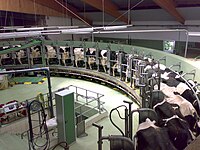
Photo from wikipedia
Intestinal parasitic infection is one of the major challenges in obtaining optimal production and maintaining the health and welfare of all animals including cattle and buffaloes. Anti-parasitic treatments appear to… Click to show full abstract
Intestinal parasitic infection is one of the major challenges in obtaining optimal production and maintaining the health and welfare of all animals including cattle and buffaloes. Anti-parasitic treatments appear to be a reliable countermeasure. However, the effectiveness and selection of suitable anthelmintics require situational assessments in a given locality. In the current study, the efficacy and impact of benzimidazole (albendazole) were assessed in a total of 400 (100 each) on the performance of buffaloes, buffalo-heifer, cattle, and cattle-heifers at two commercial dairy farms in the Province of Punjab, Pakistan. Additionally, the cost-benefit ratio was calculated by assessing the inputs (medication, feed, and labor cost) and outputs (milk and weight gain). The qualitative and quantitative examination of helminth eggs in each type of animal indicated a prevalence of 73.3, 78.3, 76.6, and 85.0% in cattle, cattle-heifers, buffaloes, and buffaloes-heifers, respectively. Specifically, a highest rate (10.0–13.3%) of Haemonchus sp. infection was only observed in cattle and heifers, while Fasciola sp. infections (10.0–11.6%) were the most often found species in buffaloes and heifers. The highest anthelmintic impacts (egg per gram of feces, p < 0.001) were observed on day 14 post-medication. Until 60 days of post-anthelmintic treatment, an average increase of 0.8 and 0.7 L in milk production per day in cattle and buffaloes, respectively while a total of 11.45 and 9.45 kg body weight were noticed in cattle-heifer and buffaloes-heifer, respectively. Cumulative cost-benefit analysis indicated a positive correlation between treated and non-treated animals. These findings reiterate the importance of anthelmintic drugs in reducing the impacts of parasites on the productivity, health, and well-being of an animal under high infection challenges.
Journal Title: Frontiers in Veterinary Science
Year Published: 2022
Link to full text (if available)
Share on Social Media: Sign Up to like & get
recommendations!